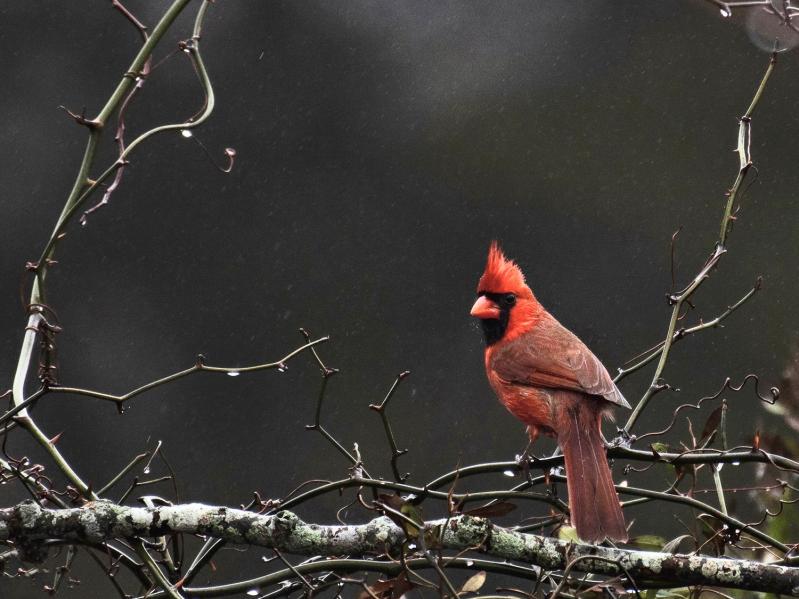In late March, under the deep sky of early dawn, when the sun is still 30 minutes from the horizon, the cardinal whistles in the dark. The trees are bare, but its song means that spring is upon us.
It’s a slurred, lusty call: two to four downward opening notes, “TYEW-TYEW-TYEW” followed by a series of trill-like faster notes, “TWO-TWO-TWO-TWO-TWO-TWO-TWO-TWO.”
“They’re one of our earliest singers,” said Holly Grant, a project assistant with NestWatch, a Cornell Lab of Ornithology program. While male birds in most species are the more recognized vocalists, female cardinals sing too, sometimes while sitting on their nest incubating eggs.
They’re nonmigratory. So, if you notice one in your yard during the winter, it could be the same cardinal there now with a female, ready to mate. “Pair formation in cardinals happens as early as January,” said Ms. Grant. Once together, they begin to defend a territory, ranging from a half-acre to six acres in size.
Perhaps because they don’t migrate, allowing them to couple early, by mid-April some cardinals will already be laying their first brood of eggs, with fledglings appearing by the first of May. This allows them to start all over and mate again, raising a second brood in the same season.
They build a four-inch-wide cup-shape nest over the course of three to nine days, so this isn’t a bird you’d attract with a house. The female “crushes twigs with her beak until they’re pliable, then turns in the nest to bend the twigs around her body and push them into a cup shape with her feet,” according to allaboutbirds.org. They prefer to nest in dogwood trees, honeysuckle, red cedar, blackberry brambles, and pines. So, if you enjoy watching these birds, consider planting those species.
Cardinals are so familiar it’s hard to perceive them, in the same way it’s hard hear an 1980s pop song you’ve heard thousands of times, or to appreciate your spouse. But try.
They’re not just red, but many shades of red. A black mask extends from their eye and surrounds their bill, which is comically large, as if it were pasted on last minute after the rest of the bird was complete. It’s a perfect tool for snapping open sunflower seeds. Cardinals also have a distinctive shape, thanks to their crests and habit of pointing their long tails groundward.
A century ago, it was a southern bird, and rare in New York. Suburbanization, climate change, and the proliferation of bird feeding are all factors that have helped the cardinal increase its range. Its population too, has grown, bucking the trend of most other birds, which have declined in the last 50 years.
Ms. Grant said it also helps that they’re “not afraid to nest near humans, their diet is varied, and they find a relatively wide range of habitats acceptable.”
Cardinals like to hide in overgrown brush, and while they’re known as feeder birds, their fledges are dependent on insects. “Messy yards are a boon for wildlife,” she said. “That doesn’t mean cardinals won’t be found in tidier yards, it’s just less likely for them to be able to find all the resources they need to succeed. Especially so if there are measures being taken to reduce insect presence.”
To put this in a local perspective, if you’re spraying for ticks and mosquitoes, you’re also spraying for baby birds. Yuck.
A psychic may tell you a cardinal is a dead relative coming to visit you. In a past article, I explained there are better birds for that, like the hermit thrush. Cardinals are too common.
Give the deceased a little space.
For me, cardinals are mixed up with childhood memories of early spring. A cold morning on a screened-in porch with my mother, watching one near a stone birdbath. Blooming forsythia and crocuses. Easter. The smell of wet earth. Now, I find myself enjoying the last spring with my first daughter before she heads to college. My second will soon be a teen.
I didn’t realize it would all happen so fast, despite repeated warnings.
I used to look through my Sibley Field Guide and list the birds I wanted to see. The painted bunting with its colorful plumage always made my short list. If I lived in California, where they’re absent, the bright red cardinal would intrigue me. But I’m old enough now to understand that if I had a painted bunting singing in my yard, I might soon ignore it and look for the next thing. That’s the sickness to avoid.
How many cardinals do you have in your life that you’re overlooking? That big, bright, obvious thing that you’re taking for granted?
Crack your window tonight, just a finger’s width, so at dawn birdsong can enter your room. And if a cardinal wakes you before your iPhone, be thankful.
(Find a nest in your yard? Learn about it and register it at nestwatch.org. They also have nest box plans for many of our common backyard birds.)

